
-
 Afrikaans
Afrikaans -
 Albanian
Albanian -
 Amharic
Amharic -
 Arabic
Arabic -
 Armenian
Armenian -
 Azerbaijani
Azerbaijani -
 Basque
Basque -
 Belarusian
Belarusian -
 Bengali
Bengali -
 Bosnian
Bosnian -
 Bulgarian
Bulgarian -
 Catalan
Catalan -
 Cebuano
Cebuano -
 China
China -
 China (Taiwan)
China (Taiwan) -
 Corsican
Corsican -
 Croatian
Croatian -
 Czech
Czech -
 Danish
Danish -
 Dutch
Dutch -
 English
English -
 Esperanto
Esperanto -
 Estonian
Estonian -
 Finnish
Finnish -
 French
French -
 Frisian
Frisian -
 Galician
Galician -
 Georgian
Georgian -
 German
German -
 Greek
Greek -
 Gujarati
Gujarati -
 Haitian Creole
Haitian Creole -
 hausa
hausa -
 hawaiian
hawaiian -
 Hebrew
Hebrew -
 Hindi
Hindi -
 Miao
Miao -
 Hungarian
Hungarian -
 Icelandic
Icelandic -
 igbo
igbo -
 Indonesian
Indonesian -
 irish
irish -
 Italian
Italian -
 Japanese
Japanese -
 Javanese
Javanese -
 Kannada
Kannada -
 kazakh
kazakh -
 Khmer
Khmer -
 Rwandese
Rwandese -
 Korean
Korean -
 Kurdish
Kurdish -
 Kyrgyz
Kyrgyz -
 Lao
Lao -
 Latin
Latin -
 Latvian
Latvian -
 Lithuanian
Lithuanian -
 Luxembourgish
Luxembourgish -
 Macedonian
Macedonian -
 Malgashi
Malgashi -
 Malay
Malay -
 Malayalam
Malayalam -
 Maltese
Maltese -
 Maori
Maori -
 Marathi
Marathi -
 Mongolian
Mongolian -
 Myanmar
Myanmar -
 Nepali
Nepali -
 Norwegian
Norwegian -
 Norwegian
Norwegian -
 Occitan
Occitan -
 Pashto
Pashto -
 Persian
Persian -
 Polish
Polish -
 Portuguese
Portuguese -
 Punjabi
Punjabi -
 Romanian
Romanian -
 Russian
Russian -
 Samoan
Samoan -
 Scottish Gaelic
Scottish Gaelic -
 Serbian
Serbian -
 Sesotho
Sesotho -
 Shona
Shona -
 Sindhi
Sindhi -
 Sinhala
Sinhala -
 Slovak
Slovak -
 Slovenian
Slovenian -
 Somali
Somali -
 Spanish
Spanish -
 Sundanese
Sundanese -
 Swahili
Swahili -
 Swedish
Swedish -
 Tagalog
Tagalog -
 Tajik
Tajik -
 Tamil
Tamil -
 Tatar
Tatar -
 Telugu
Telugu -
 Thai
Thai -
 Turkish
Turkish -
 Turkmen
Turkmen -
 Ukrainian
Ukrainian -
 Urdu
Urdu -
 Uighur
Uighur -
 Uzbek
Uzbek -
 Vietnamese
Vietnamese -
 Welsh
Welsh -
 Bantu
Bantu -
 Yiddish
Yiddish -
 Yoruba
Yoruba -
 Zulu
Zulu
frp chemical product
Understanding FRP Chemical Products Applications and Benefits
Fiberglass Reinforced Plastic (FRP), also known as Fiber Reinforced Polymer, is a composite material that consists of a polymer matrix reinforced with fibers, typically glass. This combination results in a material that boasts a number of advantageous properties, making it increasingly popular across various industries. In this article, we delve into the significance, applications, and benefits of FRP chemical products.
Composition and Properties of FRP
At its core, FRP is composed of two primary components the resin and the reinforcing fibers. The resin acts as a matrix that binds the fibers together, providing the structure. The most commonly used resins in FRP production are polyester, vinyl ester, and epoxy. Glass fibers, due to their high tensile strength and resistance to corrosion, are primarily used for reinforcement.
The unique combination of these materials yields an impressive range of properties. FRP is lightweight yet incredibly strong, with a high strength-to-weight ratio. This makes it an excellent alternative to traditional materials, such as steel and aluminum. Additionally, FRP is resistant to corrosion, chemicals, and UV radiation, which enhances its durability in harsh environments. Its electrical insulating properties also make it suitable for applications in diverse fields.
Applications of FRP Chemical Products
FRP chemical products can be found in numerous applications, ranging from construction to automotive industries. In the construction sector, FRP is used for reinforcing beams, columns, and slabs, providing both strength and reduced weight. Its resistance to moisture makes it ideal for use in bridges, storage tanks, and piping systems.
frp chemical product

In the automotive industry, FRP is employed in the production of body panels and components, contributing to weight reduction which leads to improved fuel efficiency. The aerospace sector similarly benefits from FRP, as its lightweight and strong characteristics enhance aircraft performance.
Moreover, FRP products have gained traction in the manufacturing of consumer goods. Items such as sporting equipment, outdoor furniture, and even boats often utilize FRP for its combination of strength, lightweight, and pleasing aesthetics.
Benefits of FRP Chemical Products
The benefits of using FRP chemical products are multifaceted. First and foremost is the significant weight reduction, which optimizes fuel efficiency in transportation and reduces the structural load in construction applications. This lighter weight, combined with high strength, allows for more versatile designs and applications.
The long lifespan of FRP materials is another compelling advantage. With high resistance to environmental factors, FRP structures have lower maintenance costs compared to their traditional counterparts. This is particularly beneficial in construction and infrastructure, where maintenance can be both costly and disruptive.
Moreover, FRP products exhibit excellent thermal and chemical resistance. They can withstand exposure to extreme temperatures and aggressive chemicals, making them ideal for use in chemical processing plants and other demanding environments.
In conclusion, FRP chemical products represent a significant evolution in material science, providing a robust solution for various industrial applications. Their unique properties, versatility, and cost-effectiveness make them an invaluable choice in today’s manufacturing and construction landscapes. As industries continue to seek innovative materials to meet the challenges of modern design and environmental sustainability, FRP will undoubtedly play a critical role in shaping the future.
Latest news
-
Exploring the Benefits of Top Hammer Drifter Rods for Enhanced Drilling PerformanceNewsJun.10,2025
-
High-Precision Fiberglass Winding Machine for GRP/FRP Pipe Production – Reliable & Efficient SolutionsNewsJun.10,2025
-
FRP Pipes & Fittings for Shipbuilding - Corrosion-Resistant & LightweightNewsJun.09,2025
-
Premium FRP Flooring Solutions Durable & Slip-ResistantNewsJun.09,2025
-
Premium Fiberglass Rectangular Tanks Durable & Lightweight SolutionNewsJun.09,2025
-
Tapered Drill String Design Guide Durable Performance & UsesNewsJun.09,2025









